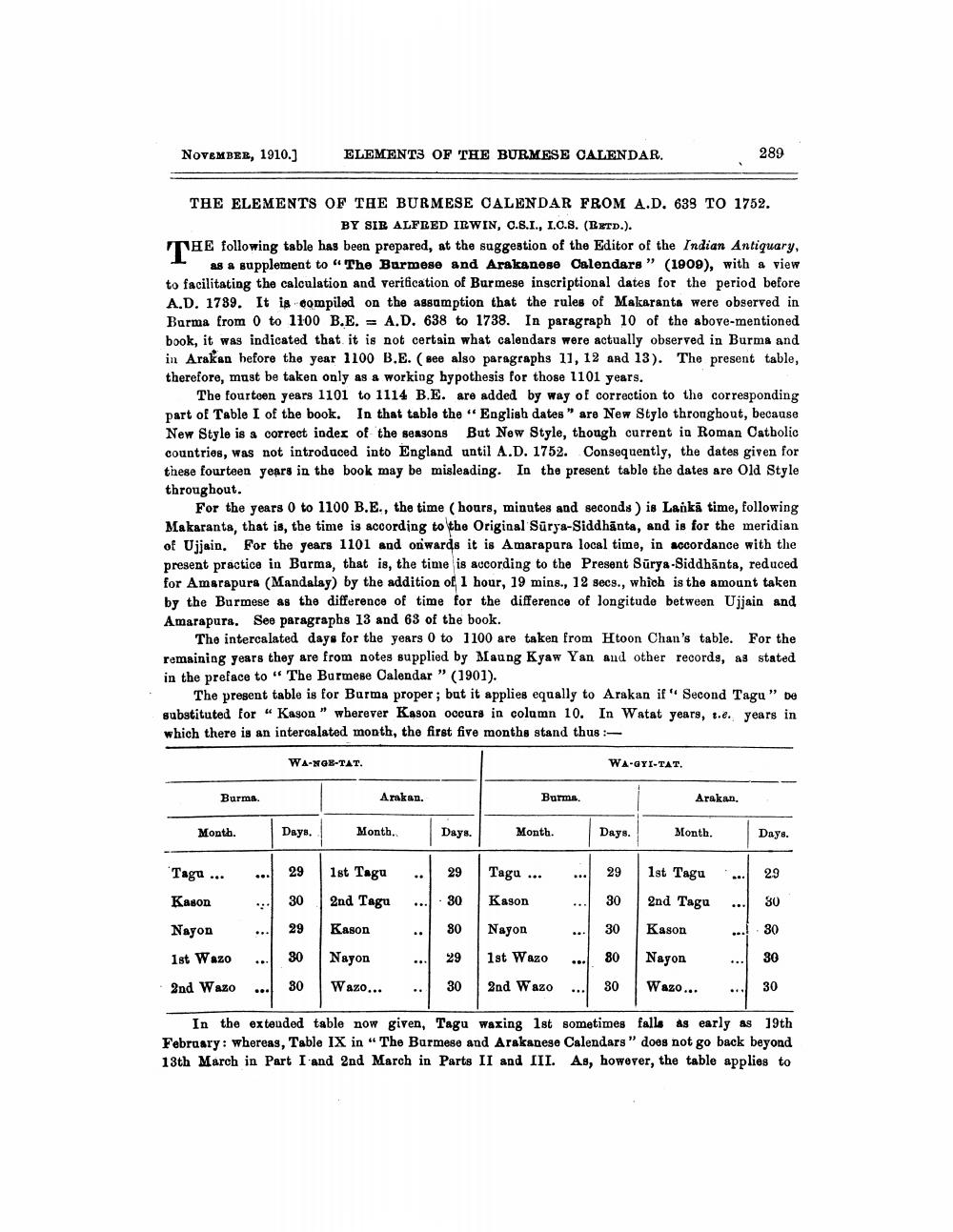________________
NOVEMBER, 1910.)
ELEMENTS OF THE BURMESE CALENDAR
289
THE ELEMENTS OF THE BURMESE CALENDAR FROM A.D. 639 TO 1752.
BY SIR ALFRED IRWIN, C.S.I., I.C.S. (LeTD.). THE following table has been prepared, at the suggestion of the Editor of the Indian Antiquary,
as a supplement to “The Burmese and Arakanese Calendars" (1909), with & view to facilitating the calculation and verification of Burmese inscriptional dates for the period before A.D. 1789. It is compiled on the assumption that the rules of Makarants were observed in Barma from 0 to 1100 B.E. = A.D. 638 to 1738. In paragraph 10 of the above-mentioned book, it was indicated that it is not certain what calendars were actually observed in Burma and in Arakan before the year 1100 B.E. (see also paragraphs 11, 12 and 13). The present table, therefore, must be taken only as a working hypothesis for those 1101 years.
The fourteen years 1101 to 1114 B.E. are added by way of correction to the corresponding part of Table I of the book. In that table the "English dates" are New Stylo throughout, because New Style is a correct index of the seasons But New Style, though current in Roman Catholic countries, was not introduced into England until A.D. 1752. Consequently, the dates given for these fourteen years in the book may be misleading. In the present table the dates are Old Style throughout.
For the years 0 to 1100 B.E., the time (hours, minutes and seconds ) is Lankā time, following Makarants, that is, the time is according to the Original Sürya-Siddhānta, and is for the meridian of Ujjain. For the years 1101 and onwards it is Amarapura local time, in accordance with the present practice in Burma, that is, the time is according to the Present Sürya-Siddhānta, reduced for Amarapura (Mandalay) by the addition of 1 hour, 19 mins., 12 secs., which is the amount taken by the Burmese as the difference of time for the difference of longitude between Ujjain and Amarapura. See paragraphs 13 and 63 of the book.
The intercalated days for the years 0 to 1100 are taken from Htoon Chan's table. For the remaining years they are from notes supplied by Maung Kyaw Yan and other records, 23 stated in the preface to "The Burmese Calendar" (1901).
The present table is for Burma proper; but it applies equally to Arakan if " Second Tagu" de substituted for “Kason" wherever Kason occurs in column 10. In Watat years, t.e. years in which there is an intercalated month, the first five months stand thus :
WA-NGE-TAT.
WA-GYI-TAT,
Burma.
Arakan.
Burma.
Arakan.
Month.
Days.
Month
Days.
Month.
Days.
Month.
Days.
..
Taga ... Kason Nayon 1st Wazo 2nd Wazo
1st Tagu 2nd Tagu Kason Nayon
Taga Kason Nayon 1st Wazo
1st Tagu 2nd Tagu Kason Nayon
... ... 30 ... 30
Wazo...
..
2nd Wazo
30
Wazo...
In the extended table now given, Tagu waxing 1st sometimes falls as early as 19th February: whereas, Table IX in "The Burmese and Arakanese Calendars" does not go back beyond 13th March in Part I and 2nd March in Parts II and III. As, however, the table applies to




